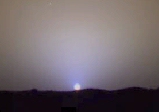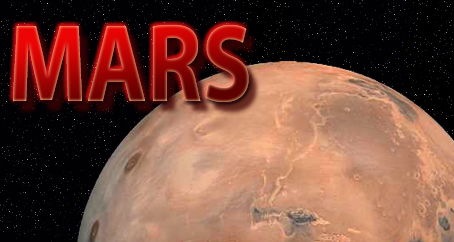Ten Facts about Mars
Fact One
Of all the planets in the Solar System, Mars is the one that people believe is most likely to contain or to have contained life. In 1900, a prize was offered to the first person to be contact an extra-terrestrial being. However, this extra-terrestrial being was not allowed to come from Mars because that would make the competition too easy! In 1938, a radio broadcast of The War of the Worlds by H.G. Wells (a story about an invasion of Earth by Martians) caused a near panic in America because so many people believed it to be true.
Fact Two
The largest volcano in the Solar System is on Mars. It is called Olympus Mons.

Fact Three
Mars has polar caps like Earth, although Mars' polar caps contain mostly frozen carbon dioxide instead of frozen water.
Fact Four
Mars is believed to have had water flowing around it like Earth once. It may have had a blue sky too. However, it is unlikely that it had grass, trees and plants like Earth has now.
Fact Five
The Valles Marineris, the greatest gorge on any planet in the Solar System, was caused when volcanoes erupting around it tore up the land, leaving a huge valley.
Fact Six
We can see how long Mars has been a 'dead' planet by the number of meteorite impacts on its surface. In comparison, Earth and Venus have fewer impact craters because they have newer surfaces formed by recent geological activity.
Fact Seven
Mars has seasons like Earth. This is caused by the tilt of the planet's axis, at a similar angle to the tilt of Earth's axis.
Fact Eight
The Sun appears about half the size on Mars as it does from Earth.

Fact Nine
The first space probe to take pictures of Mars' surface (Mariner 4 in 1964) is still in space although inactive, orbiting the Sun. Still orbiting Mars itself are Mariner 9 (launched in 1971, now in active), Viking 1 and 2 (launched in 1975, now inactive), the Mars Global Surveyor (launched in 1996, now inactive), Mars Odyssey 2001 and Mars Reconnaissance Orbiter. These are American NASA space probes. Europe's active Mars Express (launched in 2003) is currently in orbit of Mars. Russian probes orbiting Mars are Mars 2 and Mars 3 (launched in 1971), Mars 5 (launched in 1973) and Phobos 1 (launched in 1988). None of these are active. Japan launched Nozomi in 1998, but it ran out of fuel and now floats around the solar system around the Sun.
Fact Ten
Rocks from Mars have landed on Earth from meteorite impacts blasting debris through space.

View facts about other destinations

Mars Statistics Table
| Name | Mars |
| Meaning of Name | Roman God of War (Ares is the Greek equivalent) |
| Name in Foreign Languages | Mars (French, German, Russian, Latin), Marte (Spanish, Italian, Portuguese), Ares (Greek) |
| Average Distance from the Sun |
227,936,640 km / 141,633,260 miles / 1.52 A.U. Comparison with Earth: 149,597,890 km / 92,955,820 miles / 1.000 A.U. |
| Closest Distance to the Sun (Perihelion) | 206,600,000 km / 128,400,000 miles / 1.38 A.U. Comparison with Earth: 147,100,000 km / 91,400,000 miles / 0.983 A.U. |
| Farthest Distance from the Sun (Aphelion) |
249,200,000 km / 154,900,000 miles / 1.67 A.U. Comparison with Earth: 152,100,000 km / 94,500,000 miles / 1.017 A.U. |
| Diameter across equator | 6,794
km / 4,222 miles Comparison with Earth: 12,756 km / 7,926 miles |
| Diagram showing planet's size compared to the size of Earth |
 |
| Circumference around equator |
21,344 km / 13,263 miles Comparison with Earth: 40,074 km / 24,901 miles |
| Mass | 641,850,000,000,000,000,000,000 kg Comparison with Earth: 5,973,700,000,000,000,000,000,000 kg |
| Time to spin on Axis | 24 hours, 37 minutes Comparison with Earth: 23 hours, 56 minutes |
| Time to orbit the Sun | 687 days Comparison with Earth: 365 days, 6 hours |
| Distance planet travels to complete one orbit | 1,366,900,000 km / 849,400,000 miles Comparison with Earth: 924,375,700 km / 574,380,400 miles |
| Gravity (Earth = 1) | 0.38 |
| Escape Velocity | 18,072 km/h / 11,229 mph Comparison with Earth: 40,248 km/h / 25,009 mph |
| Minimum Surface Temperature | -133 °c / -207°F / 140 K Comparison with Earth: -88 °c / -126 °F / 185 K |
| Maximum Surface Temperature | 27 °c / 80 °F / 300 K Comparison with Earth: 58 °c / 136 ° F / 331 K |
| Weather Conditions | Mars is almost always sunny but very very cold. Dust in the thin atmosphere can cause haziness, and frost can form in polar regions. Thin water-ice clouds can form. Mars is extremely dry so there is never any rain on the planet (this may have been different in the past when surface water was present and the atmosphere was thicker). Mars has seasons, which means that the weather changes dependent on season - at the equator in summer, temperatures can reach up to 27 °c (80 °F). Mars is mostly calm although wind speeds can reach up to 100 mph and cause dust storms which can completely cover the planet. |
| Contents of Atmosphere | 95.3% carbon dioxide (CO2), 2.7% nitrogen (N2), 1.6% argon (Ar), and 0.1% oxygen (O2). Other gases present in tiny quantities include carbon monoxide (CO), water (H2O), nitric oxide (NO), neon (Ne), krypton (Kr), and xenon (Xe). |
| Known moons | 2 - Phobos and Deimos (both discovered in 1877 by Asaph Hall) |
| Past Missions (including nationality and year of launch - failed missions in red) | Marsnik 1 (USSR, 1960), Marsnik 2 (USSR, 1960, Sputnik 22 (USSR 1962), Mars 1 (USSR 1962), Sputnik 24 (USSR, 1962), Mariner 3 (USA, 1964), Mariner 4 (USA, 1964), Zond 2 (USSR, 1964), Zond 3 (USSR, 1965), Mariner 6 (USA, 1969), Mariner 7 (USA, 1969), Mars 1969A (USSR, 1969), Mars 1969B (USSR, 1969), Mariner 8 (USA 1971), Cosmos 419 (USSR 1971), Mars 2 (USSR, 1971), Mars 3 (USSR, 1971), Mariner 9 (USA, 1971), Mars 4 (USSR, 1973), Mars 5 (USSR, 1973), Mars 6 (USSR, 1973), Mars 7 (USSR, 1973), Viking 1 (USA, 1975), Viking 2, (USA 1975), Phobos 1 (USSR, 1988), Phobos 2 (USSR, 1988), Mars Observer (USA, 1992), Mars Global Surveyor (USA, 1996), Mars Pathfinder (USA, 1996), Nozomi (Japan, 1998), Mars Climate Orbiter (USA, 1998), Mars Polar Lander (USA, 1999), Deep Space 2 (USA, 1999), Spirit / MER-A (USA, 2003), Phoenix / Mars Scout 1 (USA 2007) |
| Present Missions | 2001 Mars Odyssey (USA, 2001), Mars Express (Europe, 2003 - this mission included the failed Beagle lander), Opportunity / MER-B (USA, 2003), Mars Reconnaisance Orbiter (USA, 2005) |
| Planned Missions | Mars Science Laboratory (USA, 2009), Mars Orbiter (USA, 2011), Mars Sample Return Lander (USA, 2014), Mars Scout 2 (USA, 2011), ExoMars (Europe, 2013), Mars Astrobiological Field Lab Rover (USA, 2016), Mars Scout 3 (USA, 2018) |
